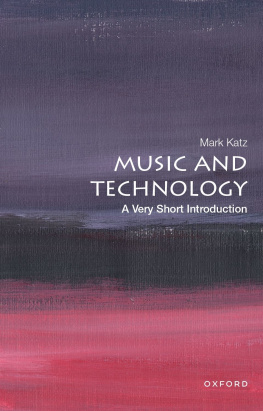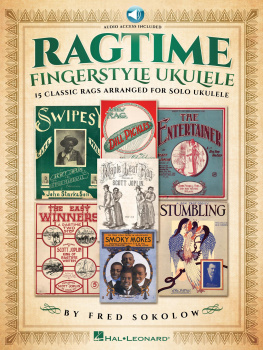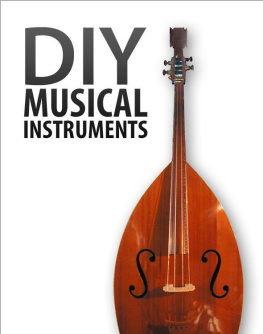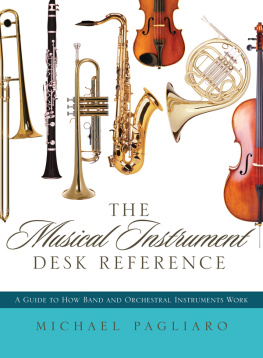JUNKYARD JAM BAND
DIY Musical Instruments and Noisemakers
DAVID ERIK NELSON
Junkyard Jam Band. Copyright 2016 by David Erik Nelson.
All rights reserved. No part of this work may be reproduced or transmitted in any form or by any means, electronic or mechanical, including photocopying, recording, or by any information storage or retrieval system, without the prior written permission of the copyright owner and the publisher.
First printing
19 18 17 16 15 1 2 3 4 5 6 7 8 9
ISBN-10: 1-59327-611-7
ISBN-13: 978-1-59327-611-9
Publisher: William Pollock
Production Editor: Riley Hoffman
Cover Design: Beth Middleworth
Interior Design: Octopod Studios
Developmental Editors: Jennifer Griffith-Delgado and Liz Chadwick
Technical Reviewer: Ron Sloat
Copyeditor: Julianne Jigour
Compositors: Riley Hoffman and Susan Glinert Stevens
Proofreader: Paula L. Fleming
For information on distribution, translations, or bulk sales, please contact No Starch Press, Inc. directly:
No Starch Press, Inc.
245 8th Street, San Francisco, CA 94103
phone: 415.863.9900;
Library of Congress Cataloging-in-Publication Data
Nelson, David Erik, author.
Junkyard jam band : DIY musical instruments and noisemakers / by David Erik Nelson. -- 1st edition .
pages cm
Summary: A collection of DIY musical instruments made from everyday materials. Projects include audio effect generators, a sequencer, an electric ukulele, a PVC slide-whistle, and an acoustic-electric thumb piano. Features step-by-step, illustrated instructions, modifications, and a soldering primer. Touches on topics like circuits, harmonics, wind instrument physics, and music theory--Provided by publisher.
ISBN 978-1-59327-611-9 -- ISBN 1-59327-611-7
1. Musical instruments--Construction. I. Title.
ML460.N43 2015
784.1923--dc23
2015018140
No Starch Press and the No Starch Press logo are registered trademarks of No Starch Press, Inc. Other product and company names mentioned herein may be the trademarks of their respective owners. Rather than use a trademark symbol with every occurrence of a trademarked name, we are using the names only in an editorial fashion and to the benefit of the trademark owner, with no intention of infringement of the trademark.
The information in this book is distributed on an As Is basis, without warranty. While every precaution has been taken in the preparation of this work, neither the author nor No Starch Press, Inc. shall have any liability to any person or entity with respect to any loss or damage caused or alleged to be caused directly or indirectly by the information contained in it.
About the Author
David Erik Nelson is an essayist, freelance writer, and award-winning science fiction author whose stories have appeared in Asimovs and The Magazine of Fantasy & Science Fiction, among others. He is the author of Snip, Burn, Solder, Shred (No Starch Press). He lives in Ann Arbor, Michigan, with his lovely wife, tolerable children, and aging poodle.
When push comes to shove, these words are my Darkened Violins; I play them for my Carnal Spider, a Lonesome Lost Nut, and a Zonal Ninja Sneeze. Otherwise, I wouldnt bother playing at all.
Brief Contents
Acknowledgments
Its a well-worn clich that any book is a team effort, and even in our magical Information Age of disintermediated self-publishing millionaires, that clich still has more than a kernel of truth. When I say This book wouldnt have been possible without the hard work of all those great folks at No Starch Press!, Im not gladhanding or buttering up No Starch Press to buy another book from me. Its quite literally the truth: I showed up with a jackstraw mash of words and some pretty threadbare photographs. The folks at No Starch Press beat that unwieldy mess into something you can actually use to make some awesomeness. From vague concept through completion, this was a complete collaboration.
First and foremost, I need to thank Jennifer Griffith-Delgado, my editor. Again, Im not overstating one iota when I say that these were crappy, confusingly written projects prior to her efforts. If you believe in a God Thing, please ask it to bless JGD for her patience and good will. While youre at it, please also ask Your Personal Notion of Grace and Forbearance to rain fortunes down upon Riley Hoffman, who is a great friend and wonderful designer and who worked tirelessly to make this all beautiful. My technical reader, Ron Sloat, brought several welcome improvements to these projects, in addition to generally keeping me honest and figuring out the true build times. Liz Chadwick and Julianne Jigour caught the vast majority of my diverse collection of mistakes, malapropisms, and unnecessarily confusing flights of fancy. Any that remain are my bad, not theirs. The fact that youre looking at these words right now indicates that you somehow heard about this books existence; I have no clue how that happened, but I know Marlon Rigel did it. He is a peach. Most of all, I need to thank No Starch Presss publisher, Bill Pollock, for his irrational faith in a book that was 26 months late and sort of crazy to begin with.
There are also plenty of folks whove never set foot in the No Starch Press offices whove done me great service: Phil Proefrock lent me his material knowhow; Jesse the Guitar Tech at the Southfield, MI, Guitar Center fronted me a geared tuner when I most needed one; Eli Neiburger and the Ann Arbor District Library furnished me with not one but two digital oscilloscopes; Craig W. Van Otteren and Jim Jett shared the intricacies of their DIY tin-can washboards; Joe Neely steadfastly attempted to teach me piano and also introduced me to the Penguin of Fifths (for which I am eternally grateful); Vince Russo, Adam Stein, and John Churchville are all excellent musicians and affable chaps whose insights on practical instrument design and construction, as well as real-world musical techniques, were truly invaluable.
.
Finally, I want to reiterate something I brush up against in Appendix C: I need to thank Everyone. The making of musicand, more importantly, the making of musical toolsis a deeply human thing that humans have done and continue to do, often with little compensation beyond the constant reminders that they are wasting their time and just making a bunch of noise while everyone else is doing something important and earning money. Im deeply indebted to every anonymous rando whos ever strummed a chord, plucked out a melody, looped a drum cut, posted to a forum about her preferred sine-wave oscillator circuit, or taken a shot at singing that One True Songwhich is to say, odds are Im deeply indebted to you, Gentle Reader and Maker of Things.
Thank you.
Introduction
Jack White (best known as the front man for The White Stripes) has a custom hollow-body electric guitar with a built-in bullet mic on a spring-loaded retractable cable. Bullet mics are traditionally harmonica mics, but White uses his for vocals. Spring-loaded cable reels are traditionally used in canister vacuum cleaners. This same guitarhe calls it the Triple Green Machinealso has a built-in phototheremin, which is a simple lightactivated synthesizer; you can build one using the schematics and notes found in Oscillators and a Metronome on .
In some respects, building a guitar like the Triple Green Machine is patently insane. White paid Randy Parsonsa renowned luthier and master of traditional American hand-building techniquesto take a really nice stock Gretsch hollow body and then cut it up, rout it out, and rewire it in ways that would have likely made Fred Gretsch weep.
















